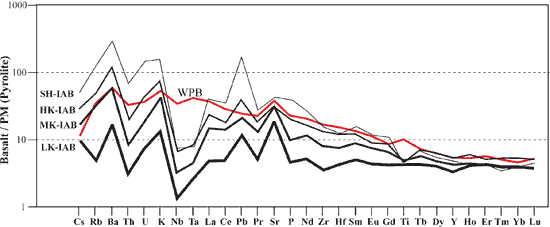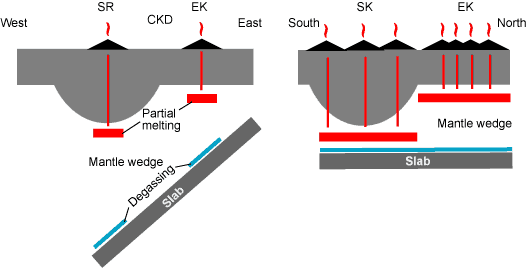The geochemistry of island-arc-type volcanic rocks from Kamchatka is controlled at least partially by lithospheric structure.
Introduction
Three volcanic belts, corresponding to the the Southern and Eastern Kamchatka ridges and the Sredinny Ridge, lie within the Kamchatka peninsula island-arc system (Figure 1). The central Kamchatka depression is located between the Eastern Kamchatka Ridge and the Sredinny Ridge volcanic belts. This depression is characterized by localization of its volcanic activity at the southern and northern ends. The Sredinny Ridge volcanic belt is atypical because of the spatial association of Ta-Nb-depleted island-arc-type- and alkaline volcanic rocks with geochemical features similar to intraplate basalts (Figure 2).
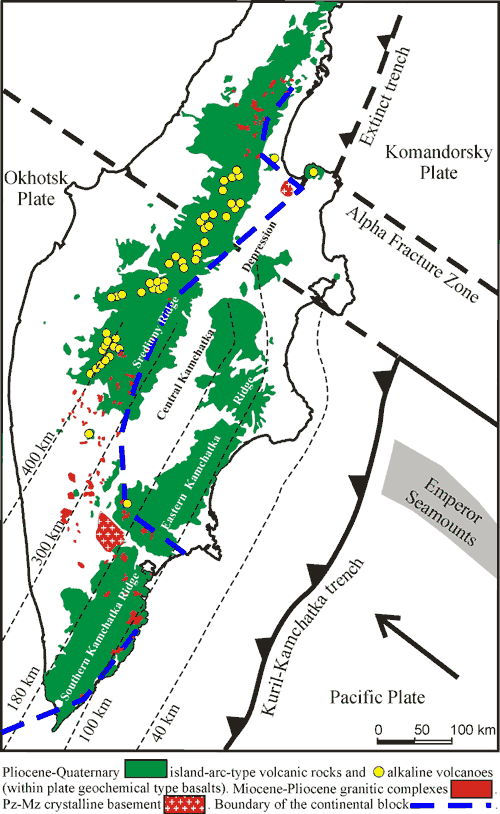
Figure 1. Structural setting of Pliocene-Quaternary volcanic rocks in Kamchatka. Thin dashed lines with numbers are depth contours of the Wadati-Benioff earthquake focal zone. The top of the figure is oriented north.
Figure 2. Trace-element, primitive-mantle-normalized diagrams for Pliocene-Quaternary basalts of the various geochemical series of Kamchatka. Composition of the primitive mantle (pyrolite) is after McDonough & Sun (1995). Acronyms: LK – low potassium series; MK – middle potassium series; HK – high potassium series; SH – shoshonitic series; IAB – island arc basalt; WPB – within-plate basalt (alkaline basalt). Representative samples are plotted. For more details of the series description see Volynets (1994). For the recent data on the WPB-type see Churikova et al. (2001), Ivanov et al. (2004) and Portnyagin et al. (2005). Click here or on figure for enlargement.
Several different models have been suggested to explain the origin of atypical alkaline volcanic rocks (Avdeiko & Palueva, 2003; Churikova et al., 2001; Ivanov et al., 2004; Portnyagin et al., 2005; Tatsumi et al., 1995; Volynets, 1994). Some of these models assume unusual conditions in the modern Pacific subducting slab system (Tatsumi et al., 1995; Churikova et al., 2001), while others postulate the presence of ocean-island-arc material in the melt source (Churikova et al., 2001) or a contribution from a mantle unmodified by subduction processes because of various processes (slab-window – Avdeiko & Palueva, 2003; asthenospheric lateral flow – Portnyagin et al., 2005; a mantle plume – Volynets, 1994). On the basis of inverse trace-element modeling we suggest a source for the alkaline volcanic rocks of recycled Kula paleoslab oceanic crust from as deep as the lowermost part of the mantle transition zone (Ivanov et al., 2005).
Alkaline volcanic rocks inherit some "subduction" trace element features (e.g., moderate depletion in Ta and Nb, and enrichment in Pb and Sr). Therefore it is important to understand better the origin of typical subduction-related volcanic rocks. Despite so large a spectrum of opinion on the origin of alkaline basalts, almost all studies accept that the geochemistry of island-arc-type volcanic rocks is dependent mainly (only?) on the depth of degassing within the subducting slab (i.e. the depth of the Wadati-Benioff seismic zone, Figure 1). Here we summarise a compilation of ~200 trace-element analyses obtained by inductively coupled plasma mass spectrometry (ICP-MS) for typical island-arc-type basalts from Kamchatka. Half of these are the authors’ unpublished data. This compilation strengthens the case that the geochemistry of island-arc-type volcanic rocks is controlled, at least partially, by the lithospheric structure of the Kamchatka peninsula. A discussion of alkaline volcanic rocks of intraplate geochemical affinity will be presented in a later webpage.
The lithospheric structure of Kamchatka
The lithospheric structure of the Kamchatka peninsula is heterogeneous. A number of studies show that the western and southern parts of the peninsula are composed of continental-type crustal blocks, whereas the eastern part is formed from intra-oceanic island-arc accreted terranes. Therefore, eastern Kamchatka has thinner crust of oceanic type (Shapiro et al., 1987; Bogdanov & Chechovich, 2004). The boundary of the continental crust is marked by the exposure of Paleozoic? – Mesozoic granitic and metamorphic complexes and by Neogenic granitoids derived by crustal anatexis (Antipin & Perepelov, 2004) (Figure 1).
Trace element and Sr-isotope variations in island arc basalts
Trace-element variations in low-, medium- and high-K basalts are attributed to world-wide across-arc zoning (i.e. increase in large-ion-lithophile (LIL) and light rare-earth elements (LREE) with increasing depth of subducting slab degassing, reflected in the depth of the Wadati-Benioff seismic zone; Miyashiro, 1974). Such variations within the island-arc-system of Kamchatka have been attributed to the same effect (Volynets, 1994; Churikova et al., 2002). However, if this is so, the Pliocene-Quaternary volcanic complexes with island-arc geochemistry (Figure 2) should reflect the local depth of the Wadati-Benioff seismic zone. In other words, the Southern and Eastern Kamchatka volcanic belts should be geochemically similar but should differ from the Sredinny Ridge volcanic belt, because the first two are underlain by the subducting slab at 100-180 km and the latter at 300-400 km depth (Figure 1).
However, the opposite is true. The island-arc geochemical type basalts of the Southern volcanic belt differ from those of the Eastern volcanic belt but bear similarities with basalts from the Sredinny Ridge volcanic belt. In general, the South Kamchatka and Sredinny Ridge island-arc geochemical type basalts are characterized by higher LIL and LREE compared to the Eastern Kamchatka basalts (Figure 2). This can be seen on various diagrams (Figures 3-6).
Despite the difference in the trace elements, the 87Sr/86Sr ratios in island-arc geochemical type basalts from all the three volcanic belts are indistinguishable from each other. They are all restricted to the narrow range of 0.7033-0.7037 (Figure 5).
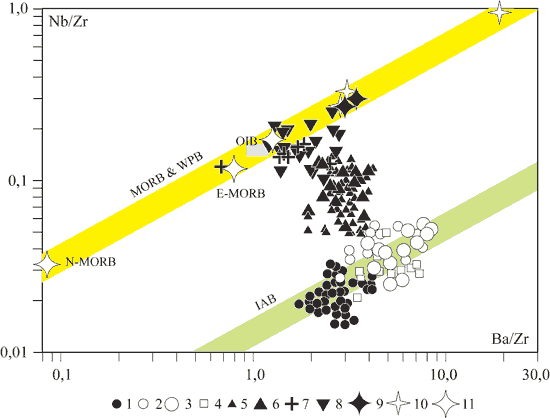
Figure 3. Nb/Zr-Ba/Zr diagram for various types of volcanic rock from Kamchatka (modified after Perepelov et al., in press). 1 – LK and MK IAB of the Eastern Kamchatka volcanic belt; 2 and 3 - MK and HK IAB of the Southern Kamchatka and Sredinny Ridge volcanic belts respectively; 4 - shoshonitic and K-alkaline basaltoids of western Kamchatka (not shown in Figure 1 because of their Paleogene age); 5 and 6 – MK and HK WPB respectively of the Sredinny Ridge volcanic belt; 7 – WPB rocks from Nachikinsky and Hailulya volcanoes (the two northeastern alkaline volcanoes in Figure 1) (Portnyagin et al., 2005); 8 and 9 – alkaline basalts and basanites of eastern and western Kamchatka respectively (not shown in Figure 1 because of their Miocene age); 10 – average compositions of basanites and alkaline basalts of the Rungwe Province, East African rift system (Ivanov et al., 1998), Chad (Gourgaud & Vincent, 2004) and Oman (Worthing & Wilde, 2002); 11 – composition of oceanic basalts (N- and E-MORB – normal and enriched mid oceanic ridge basalts, respectively; OIB – oceanic island basalt) (Sun & McDonough, 1989). Each Kamchatkan geochemical type is represented by new data belonging to the authors plus published ICP-MS data (Churikova et al., 2001; Grib et al., 2003; Ivanov et al., 2004).
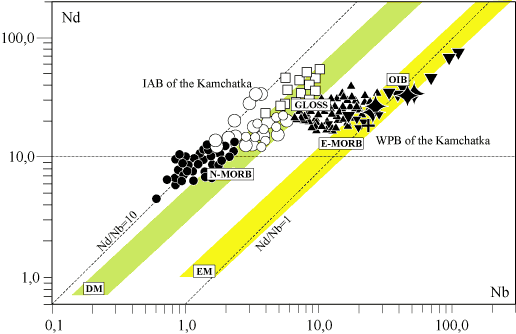
Figure 4. Nb-Nd diagram for various types of volcanic rock from Kamchatka. Symbols as for Figure 3.
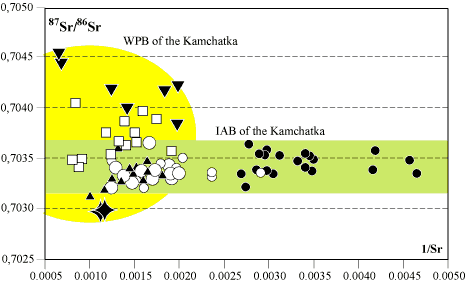
Figure 5. 87Sr/86Sr vs 1/Sr for the IAB and WPB of Kamchatka. Symbols as for Figure 3.
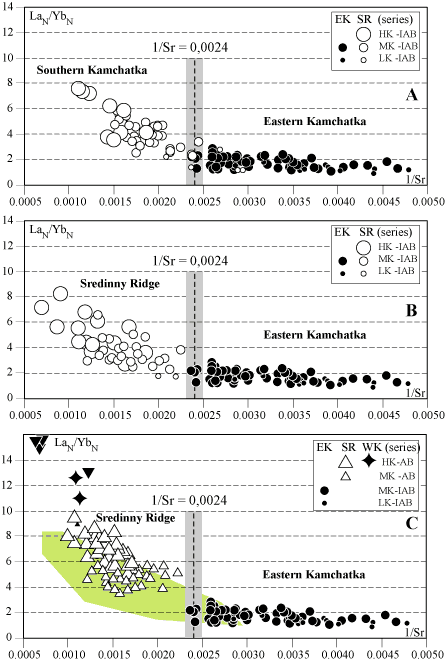
Figure 6. Trace element features of IAB and WPB from the three volcanic belts of Kamchatka as reflected in the LaN/YbN-1/Sr diagram. La and Yb concentrations are normalized to Cl (McDonough & Sun, 1995). On all three diagrams black circles represent compositions of IAB from the Eastern Kamchatka volcanic belt. In A and B open circles represent compositions of IAB from the Southern Kamchatka and Sredinny Ridge volcanic belts, respectively. In C the coloured field represents the general compositional range of IAB from the Southern Kamchatka and Sredinny Ridge volcanic belts. Alkaline volcanic rocks of the WPB type are plotted for comparison in C. Acronyms: EK – Eastern Kamchatka, SK – Southern Kamchatka; SR – Sredinny Ridge, WK – Western Kamchatka; AB – alkaline basalts and basanites. Other acronyms as in Figure 2.
Discussion and conclusions
From the data above it can be seen,on one hand, hat the island-arc geochemical type basalts of the Southern Kamchatka and Sredinny Ridge volcanic belts are similar to each other, despite the large difference in depths of the Wadati-Benioff focal earthquake zone. On the other hand, the Southern and Eastern Kamchatka volcanic belts are situated above parts of the Wadati-Benioff seismic zone of equal depth, yet their basalts are different in key trace element concentrations and ratios (Figures 3, 4 & 6). Therefore, a process or processes other than degassing of the subducting slab must be responsible for controlling the trace-element chemistry of the island-arc geochemical type of basalts, at least in Kamchatka.
Both the Southern Kamchatka and Sredinny Ridge volcanic belts are situated within the continental lithosphere (Figure 1). From this, and the charactaristics of the basalt chemistry, we hypothesise that the primary control of the trace-element variations is lithospheric structure. The lithosphere can control the chemistry of primary sublithospheric magmas in two ways, by;

